Nokia Lumia 630 Review
by Brett Howse on July 22, 2014 8:00 AM EST- Posted in
- Smartphones
- Microsoft
- Nokia
- Mobile
- windows phone
Camera
Budget phones often have budget cameras, and the Lumia 630 is no exception. The camera module is a 5 MP 1/4” design. This means the pixels are 1.4 µm. It is an autofocus design, but lacks any sort of flash assist. I don’t really like the flash of most smartphones anyway, since the LED often isn’t bright enough to really illuminate the scene, and instead blows out the color accuracy of whatever you are trying to capture. However when you are working with a device with a 1/4” sensor, you are going to need a flash for any sort of low light photography so it’s absence is certainly missed here. I also quite often use the LED flash as a flashlight, so it was doubly missed.
To measure camera performance, we’ll put it through several test scenes and compare it to other devices. We’ll start with the ISO 12233 test chart, and look specifically at the sagittal and tangential lines to see how well the camera can capture fine detail.
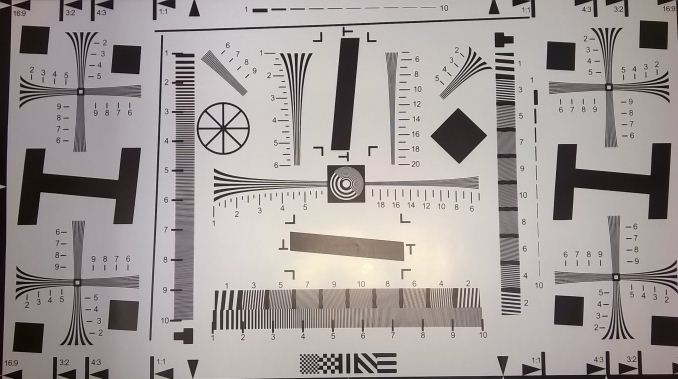 ISO 12233 Test Chart captured by Nokia Lumia 630
ISO 12233 Test Chart captured by Nokia Lumia 630
The Lumia 630, unsurprisingly, does a poor job of resolving fine detail. 5 MP isn’t a lot to work with, and with such a small sensor size it really struggles to capture enough light. The gallery below will allow you to compare it to other devices.
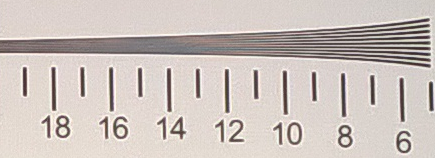
Once cropped, we can really see the shortcomings of the camera system. A common theme that I found while using the phone is that it does a reasonable job capturing a scene, but any sort of cropping of the scene later will result in an unusable image.
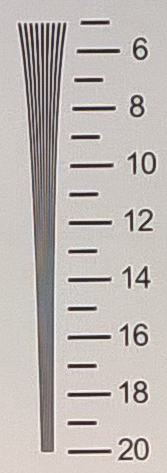
The story is the same for the tangential crop. Once zoomed in, all detail is lost. The only good news is that the 630 appears to use the same camera module as the 520 and 620, so there shouldn’t be a regression here from last year’s models.
Lab Scenes
To get a feel for how the Lumia 630 can shoot pictures under a controlled environment, we have the following sample photos comparing it to the Lumia 1020. I also included the high resolution photos from the 1020 just to see how it does pixel binning to improve the image quality of the low resolution shots. These shots were all taken with the cameras set to their default automatic modes, and the Lumia 630 defaults to 16:9 where as the Lumia 1020 defaults to 4:3 photos.
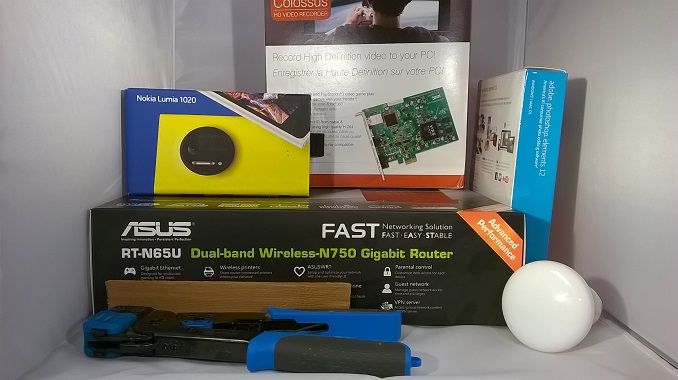
In the well lit controlled photos, the Lumia 630 does very well. It has good white balance, and the detail is actually pretty good. The white balance is better than the Lumia 1020 in this case, which historically has struggled with white balance in certain scenarios. Next up, we'll test both in a low light controlled scenario. You can use the gallery below to sample full resolution images from this test.
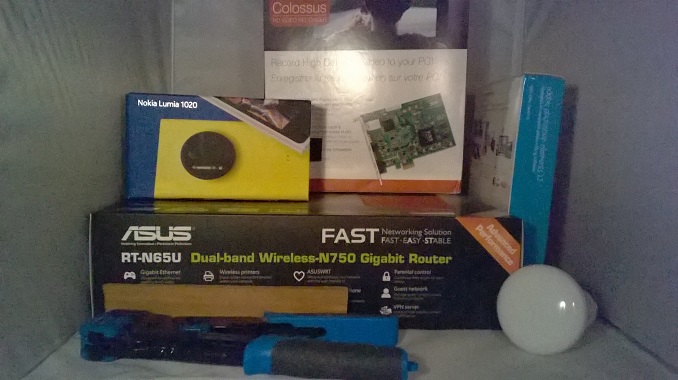
For the low light shots, the ambient light is dropped to 5 lux. Unsurprisingly, with such a small sensor size the Lumia 630 really struggles to capture enough light to properly portray the scene. The picture has a lot of noise in it. This is why a flash is so important on a phone such as this, as it makes shooting any sort of dim scene very difficult. LED flashes often blow out the shot, but at least they make the shot possible. The Lumia 1020, with its 1/1.5" sensor absolutely trounces the 630 in this test. I also included the high resolution shots for the 1020 in this test just to see the pixel binning in action. The high resolution shot actually comes across with slightly less pop than the low resolution image, even though both are very good. It's especially noticeable on the white text on the router box. You can use the gallery below to sample full resolution images from this test.
Outdoor Scenes (Night)
Moving away from controlled scenes to outdoor scenes, we can see how the Lumia 630 fares under real world conditions. First up, we’ll check out its low light performance with a picture of a park bench, lit by a nearby path light.

Going into the review, my assumption was that the newer ISP of the Snapdragon 400 SoC would result in slightly better shots than the outgoing 620, but that wasn’t the case. Both devices struggled with the low light shots, but the 620 was able to achieve a better focus lock before taking a picture. The 630 did take pictures faster, but the results aren’t great in low light.

Next up is the picture of a Supermarket sign at night. Here we see similar results, with the Lumia 620 having a better white balance and better overall shot than the 620. The 620 actually has better white balance than even the Lumia 1020 in this comparison, even though the 1020 has a clearer result.
Outdoor Scenes (Daylight)
For the daylight pictures, the story changed. With enough light, the Lumia 630 can take some excellent pictures. It did have a tendency to oversaturate the images slightly, but generally the pictures were quite good.

This photo gives a good example of the oversaturation, with the Lumia 630 coming in a bit too dark for the building. The Lumia 620 undersaturated the image a bit here.
This crop compares all three photos of the flower, and demonstrates that even with sufficient light, once you zoom in on a photo with the Lumia 630, it results in a blurry image much like the Lumia 620. Overall, for daylight shots, the Lumia 630 actually does surprisingly well assuming you don’t want to zoom in on the results. Some of the pictures were oversaturated, but generally the white balance was good, and brightness and detail were both ok for a 5 MP result.
Capture Latency
The arrival of a new ISP has really helped with the speed of the camera. Both focus latency and shot latency are very good, and generally much improved over the prior generation of devices. There are no fancy rangefinders, so we’re not going to break any records, but it’s still a good result.
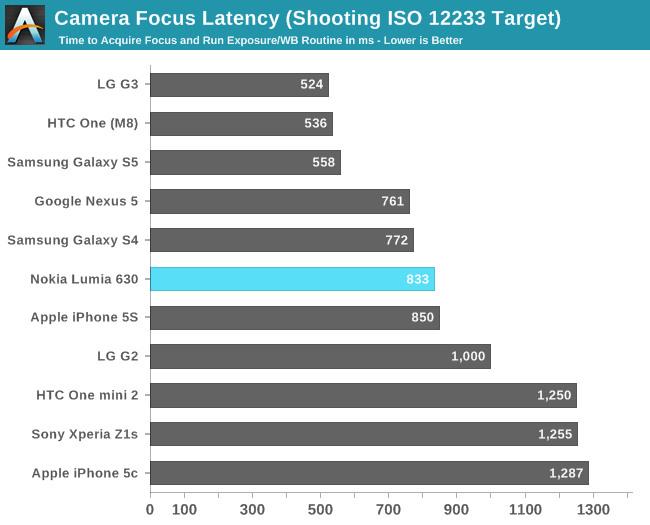
With a 833 ms focus capture, you can grab focus pretty quickly. While not up there with today’s flagship devices where focus latency seems to be a competition, it still comes in better than other devices costing much more.
Once you have focus lock, the next step is of course to take the photograph, and for that we analyze the time in between each capture.
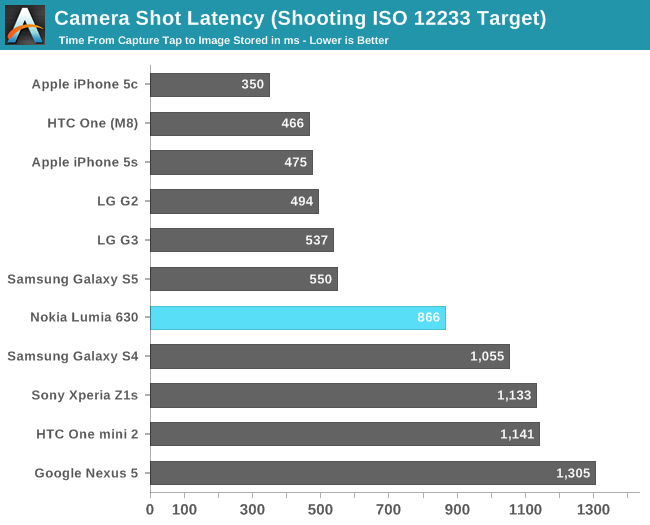
The camera latency is slightly longer than most of today’s flagship devices but it still comes in at a reasonable 866 ms. For a device at this price point, that’s a good result.
For total Camera Latency, we add the previous numbers together and compare total time to capture an image.
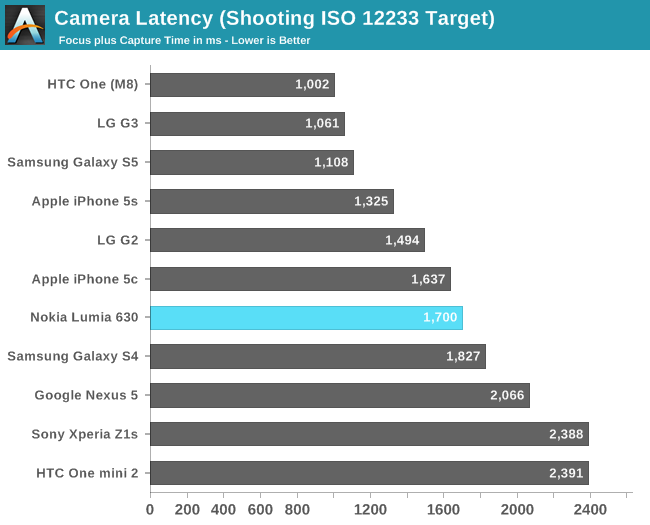
With an average focus lock and an average capture time, the Lumia 630 falls in to the middle of the pack, which is a good result for a device in this price range.
Video
The Lumia 630 is limited in what it can shoot for video. There are no options to change the resolution or frame rate at all on this device, so you are stuck with 720p30 video. With such a small sensor both in terms of size and pixels, this is probably all you can expect from the device even though the ISP can handle 1080p video.
The video quality is not exceptional, with a lot of detail missing. Being a $160 phone, it of course lacks any sort of optical image stabilization.


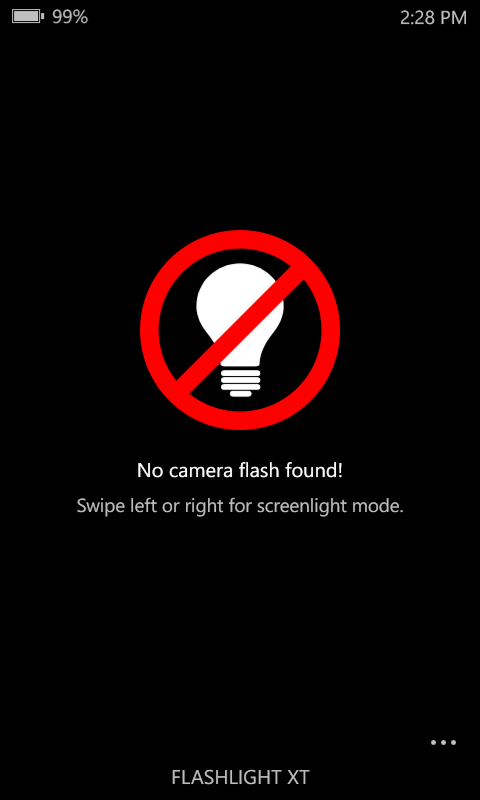































































83 Comments
View All Comments
kyuu - Tuesday, July 22, 2014 - link
Maybe the app, but there's no way for them to prevent you from using Google search in general.Regardless, who cares? Use Bing.
skiboysteve - Tuesday, July 22, 2014 - link
using google search on a windows phone is a really bad idea. I'm glad they got rid of this option. The bing integration is absolutely fantastic and has a great, fast, beautiful, and intuitive interface when you hit the 'search' button.plus if you sign up for bing rewards, simply using your phone for a month gives you enough points for free gift cards
Cerb - Wednesday, July 23, 2014 - link
What exactly is integration of search good for, compared to any other searching?skiboysteve - Thursday, July 24, 2014 - link
Why do we even have apps instead of going to mobile websites? Same thingCerb - Saturday, July 26, 2014 - link
That doesn't make any sense to me, either, when there is a website to use. My phone is quite capable of using most desktop website versions, and doing so is typically much quicker and easier than trying to deal with app, or a mobile site (crazy cluttered sites, like IMDB, are exceptions, but luckily, they aren't the norm).tuxRoller - Wednesday, July 30, 2014 - link
This is sort of how fxos works, and, since the browser engine is always running, starting those apps should be quite fast.If you look at eideticker (the fxos performance tool/dashboard) you can see startup times for various "apps". Even on low end hardware they're pretty good (and the nightlies are so much faster still).
1d107 - Tuesday, July 22, 2014 - link
T-Mobile version, Lumia 635, has LTE and internet sharing with Wi-Fi devices. Would be nice to get speed tests for it. Is there any difference in other features between 630 and 635?On the other hand, for a slightly higher price, a two-year old old HTC 8X has a lot more features, while being nearly the same size and weight.
Brett Howse - Tuesday, July 22, 2014 - link
The 635 is identical except for the SoC which is the MSM8926 which supports LTE, but has the same quad-core Cortex A7 and Adreno 305 GPU.SydneyBlue120d - Tuesday, July 22, 2014 - link
Do You plan to do a review of the Nokia 930 too? Thanks.frostyfiredude - Wednesday, July 23, 2014 - link
This I'd be interested in, I'm semi looking at it for my next phone. My HTC 8X is nearing it's end so it's looking like a good replacement right now.So close to a potential 64-bit and 20nm FinFET release makes me question it though, for the sake of future proofing going 32-bit today seems iffy.